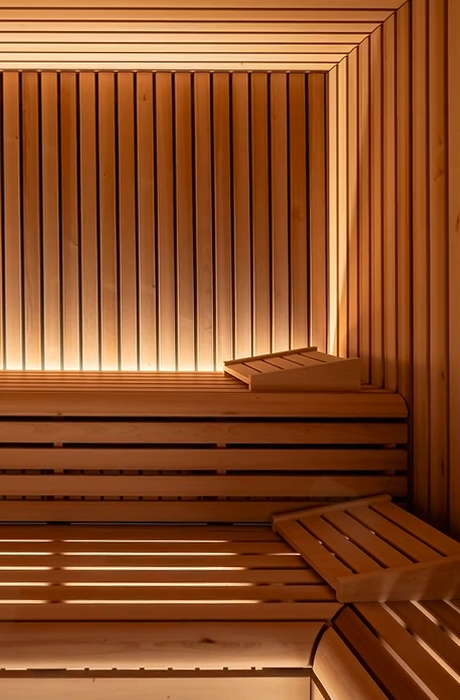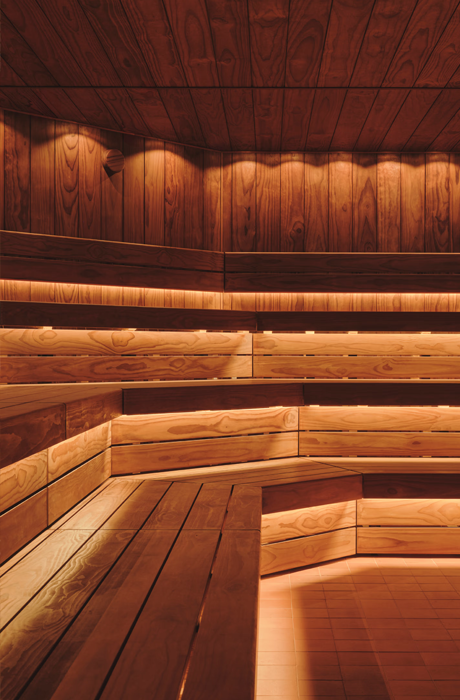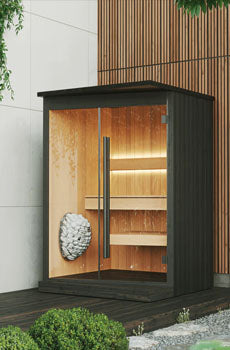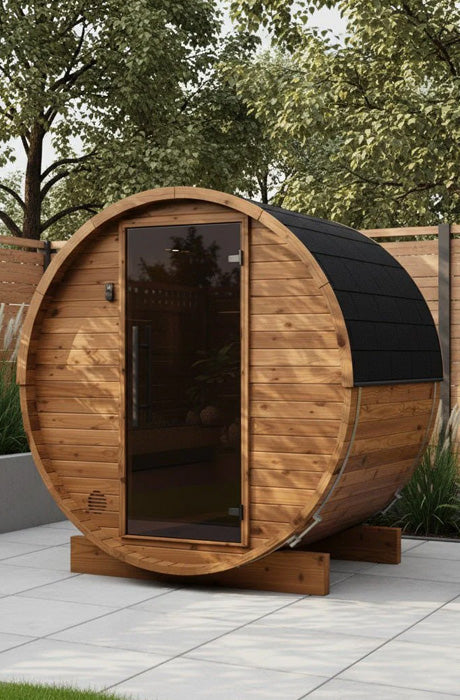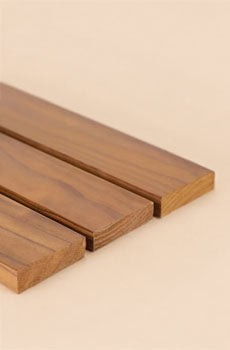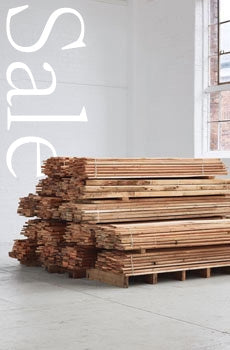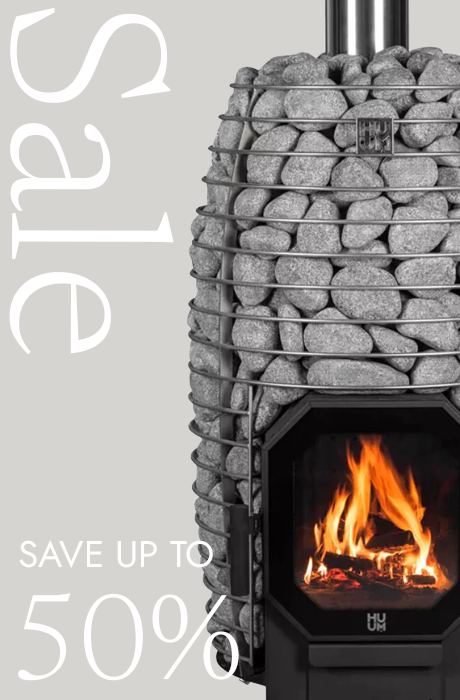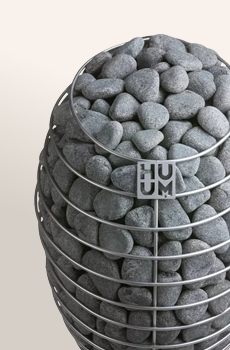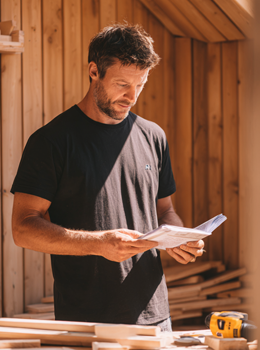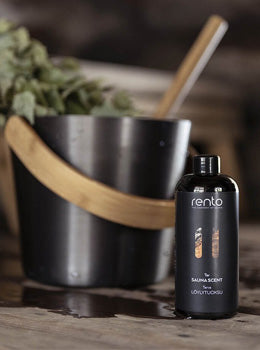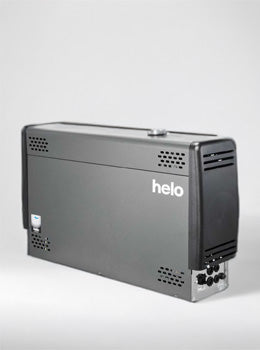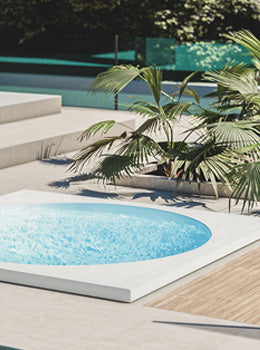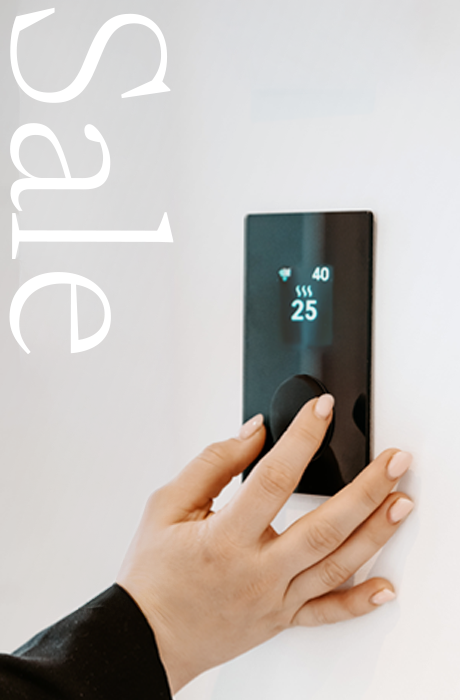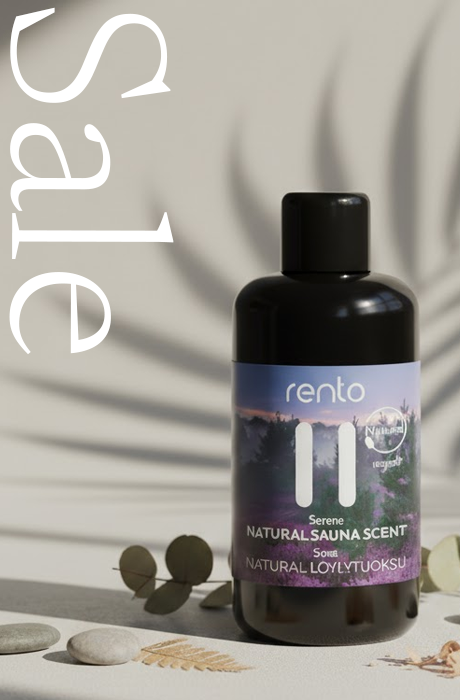
Sauna Stones: Everything You Need To Know
Did you know that badly maintained sauna stones can drastically influence the amount of energy wasted when heating up your sauna? Have you noticed a change in the time it takes for your sauna to reach temperature? Does the steam feel weaker when you pour water onto the stones of your heater? Are there small crumbles of stones in front of your heater? These signs indicate that it might be time to upgrade your sauna stones to fresh ones.
We at Finnmark Sauna have answered four frequently asked questions about sauna stones that will help with the maintenance of your heater and ensure a pleasant sauna session. After all, you shouldn't let degraded stones compromise the perfect "löyly".
1. Why Should You Change Your Sauna Stones?
High-quality sauna stones are at the heart of an authentic sauna experience. The hot stones in the sauna heater create the renowned "löyly", which refers to the evaporated hot steam you get when water is thrown onto them.
Old and damaged sauna stones may not only result in a disappointing "löyly" but can also damage the heating elements, waste energy (especially important to look at when trying to decrease energy costs) and compromise the air quality of the sauna.
This is why sauna stones are recommended to be checked and upgraded every 1-2 years, depending on how often the sauna is used.

The Hidden Cost of Degraded Sauna Stones
Many sauna owners overlook this simple sauna stone maintenance task, not realising that their stones are quietly driving up their energy bills month after month. Sauna stones are the thermal heart of your sauna; they absorb heat during the warming phase and radiate it consistently throughout your session.
When sauna stones degrade, crack, or crumble, they break down and settle into a tightly packed structure, which reduces airflow through the stones and heating elements. This restricted airflow means the heater cannot efficiently heat the air, forcing it to work harder and longer to maintain the desired temperature.
This not only increases your electricity costs but also accelerates wear on your heating elements, potentially leading to expensive repairs or replacements down the line. Proper sauna stone maintenance and piling the stones correctly will save on the monthly bill and can reduce energy consumption by up to 15%.
The Science Behind Sauna Heating Stones
Sauna heating stones function as natural thermal batteries, absorbing heat energy from your heater and releasing it slowly and evenly throughout your session. This thermal mass is what differentiates an authentic sauna experience from other heat therapies. When water is poured onto properly heated sauna rocks, it creates that distinctive crackling sound and clouds of enveloping steam that sauna enthusiasts cherish.
The quality of your sauna stones directly affects heat distribution, steam production, and energy efficiency. Degraded sauna rocks lose their ability to retain heat effectively, meaning your heater must work harder and longer to maintain the desired temperature.
Safety Considerations for Sauna Rocks
Beyond performance, there are important safety reasons for maintaining quality sauna stones. Stones that have developed internal cracks or have become too porous can potentially fracture when subjected to rapid temperature changes. Whilst this is rare with properly selected sauna stones, it's a risk that increases as stones degrade over time.
Poor quality sauna stones can also release dust particles and mineral deposits into the air when heated, compromising the air quality in your sauna and potentially causing respiratory irritation.
2. When Should You Replace Sauna Stones?
If sauna is a part of your weekly routine, the sauna stones should be checked at least once a year. The more you use your sauna and the higher the temperatures, the more often the stones will need replacing. If you heat up the sauna at least twice a week, it's best practice to unload the stones every six months. In case the sauna is not in use every week, once a year will suffice.
Sauna Stone Replacement Schedule Based on Usage
For frequent users (3+ times per week): Inspect your sauna stones every 3-4 months and expect to replace stones annually or sooner.
For regular users (1-2 times per week): Inspect sauna rocks every 6 months, with replacement typically needed every 1-2 years.
For occasional users (monthly or less): Annual sauna stone inspection is sufficient, with stones potentially lasting 2-3 years.
Commercial saunas with daily use require much more frequent sauna stone inspection and replacement, often every few months, depending on the intensity of use.
Before You Check Your Sauna Stones
Make sure to check that the heater is switched off and the sauna stones have fully cooled down before removing them. We recommend wearing gloves when unloading old sauna rocks from the heater. They will protect your hands from dust, any sharp edges of the heater and cracked stones.
It's also helpful to have a bucket or container ready to place the sauna stones in as you remove them. This allows you to inspect each stone individually and sort them into "keep" and "replace" piles.
Sauna Stone Maintenance Tips for Optimal Performance
Following these simple sauna stone maintenance practices will help you maximise energy efficiency and prolong the life of your heating elements:
-
Replace sauna stones annually or when they show signs of degradation
-
Pile sauna rocks with small gaps between them for proper airflow
-
Avoid piling sauna stones too tightly, which restricts airflow and increases energy consumption
-
Check for cracked or crumbling sauna stones that reduce heat retention and settle into compact layers
-
Remove stone fragments from the bottom of your heater during inspection to maintain airflow
When sauna stones are properly maintained and correctly arranged, you can reduce energy consumption by up to 15% whilst ensuring your sauna reaches temperature efficiently every time.
3. What Are the Signs of Degraded Sauna Stones?
Visible signs of old sauna stones are changes in colour. Old sauna rocks may turn from dark grey to lighter grey, rusty brown, white or even green. Small crumbles of stone often end up on the floor in front of the heater. Some of the stones may have cracks in them, or they may have broken down into multiple pieces. You can test the sauna stones by gently tapping two stones against each other. The stones that crack or make a hollow sound should be discarded and replaced with fresh ones.
How to Identify Worn Sauna Rocks: Warning Signs
Visual indicators of degraded sauna stones:
-
Discolouration from their original dark grey or black appearance
-
White, chalky residue or mineral deposits on the surface of sauna rocks
-
Visible fractures, cracks, or fissures in sauna stones
-
Sauna stones breaking into smaller pieces
-
Crumbling edges or surfaces on sauna rocks
-
Stone fragments are accumulating at the bottom of the heater
Performance indicators that the sauna stones need replacing:
-
Reduced steam production when water is applied to sauna rocks
-
Longer heat-up times than usual
-
Increased energy consumption
-
Uneven heat distribution in the sauna
-
Unusual odours when the heater is in use
-
Sauna stones shifting or settling more than usual, creating a tightly packed arrangement
Physical testing for sauna stone quality: The "tap test": Gently strike two sauna stones together. A clear, solid "clink" indicates good stones; a dull "thud" suggests the stone is too porous or internally damaged. Sauna rocks that produce a hollow sound should be replaced immediately.
Understanding Sauna Stone Degradation and Energy Impact
Over time and with repeated heating and cooling cycles, even the highest quality sauna stones undergo thermal stress. This is a natural process where the extreme temperature variations cause microscopic changes in the sauna stone's structure. Eventually, these changes become visible as cracks, discolouration, or crumbling.
As sauna stones break down, the smaller fragments settle into the gaps between larger stones, creating an increasingly dense, compacted layer. This compaction is the primary reason for reduced energy efficiency; it blocks the natural airflow that allows your heating elements to work effectively. The rate of sauna stone degradation depends on several factors, including the stone type, frequency of use, temperature extremes, and how water is applied.
4. Types of Sauna Stones: Which Are Best for Your Heater?
The most important aspects of high-quality sauna stones are their shape, size and thermal conductivity. Grade A Finnish Olivine Diabase Stones or Vulcanite Sauna Stones are a great choice for any wood-burning or electric sauna heater.
Olivine Diabase Sauna Stones: The Traditional Finnish Choice
Olivine diabase is a traditional, high-quality sauna stone noted for its durability and excellent soft steam created when water is poured on top of it. This volcanic sauna rock has a density of approximately 3.5 kg/dm³, which gives it exceptional heat retention properties.
What makes olivine diabase sauna stones particularly special is their resistance to thermal shock. These sauna rocks can withstand hundreds of heating and cooling cycles without breaking down, making them one of the longest-lasting sauna stone options available. The stone's crystalline structure allows it to store large amounts of heat and release it slowly and evenly, producing that thick, rolling steam that characterises an authentic Finnish sauna experience.
Some heaters, such as the HUUM DROP, look particularly attractive with rounded Olivine Diabase Sauna Stones, which offer a more refined aesthetic whilst maintaining all the functional benefits of quality sauna rocks.
Vulcanite Sauna Stones: The High-Performance Option
Vulcanite is a slightly darker coloured and durable igneous rock used as sauna stones. It has a higher metal content, which helps it store heat and is ideal for sauna users who heat up the sauna multiple times a week and have the heater on for longer periods.
Whilst slightly more expensive than standard olivine diabase sauna stones, vulcanite's superior heat retention can actually result in energy savings over time, as your heater won't need to work as hard to maintain temperature. This makes vulcanite sauna rocks an excellent investment for dedicated sauna enthusiasts.
Sauna Stone Sizes: Understanding the Right Dimensions
Typically, sauna stones come in two sizes: 5-10 cm and 10-15 cm. You should always check what-sized sauna stones are recommended for your heater. Generally, the smaller-sized sauna rocks are suitable for most electric heaters and the larger sauna stones for wood-burning heaters. However, there are exceptions to this.
Why sauna stone size matters:
Different-sized sauna stones serve different purposes in your heater. Larger sauna rocks provide long-term heat retention and form the foundation of your stone arrangement. They heat up more slowly but maintain their temperature for extended periods. Smaller sauna stones, positioned on top and between larger stones, heat up quickly and provide a rapid steam response when water is applied.
The ideal approach for arranging sauna rocks is a layered strategy: place larger sauna stones at the bottom (or around heating elements in electric heaters), use medium sauna rocks to fill the main body, and top with smaller sauna stones where you'll be pouring water. This maximises both heat retention and steam quality whilst ensuring proper airflow through the sauna stone arrangement.
How to Arrange Sauna Stones for Best Performance
Proper stacking of your sauna stones is crucial for both performance and energy efficiency. Sauna stones should be placed with small gaps between them to allow air circulation—this is essential for efficient heating and optimal energy consumption.
When sauna rocks are piled too tightly, airflow is restricted, forcing your heater to work much harder to reach and maintain temperature. This not only wastes energy but also puts unnecessary strain on your heating elements.
When arranging sauna stones in an electric heater, take care not to press them against the heating elements, as this can cause localised overheating and premature element failure. In wood-burning heaters, larger sauna rocks typically go at the bottom where they're in the direct path of the fire.
The top layer of sauna stones should be arranged more closely together (but still with some gaps), as this is where most steam generation occurs. You want enough coverage to prevent water from dripping directly onto heating elements whilst still maintaining airflow throughout the sauna stone arrangement.
Why You Must Use Proper Sauna Stones (Not Random Rocks)
You should never use just any stones in your sauna heater. Specialised sauna stones, like the ones we supply at Finnmark Sauna, have been specifically selected for their high thermal capacity and mineral composition, making them suitable to use in the hot and humid conditions of a sauna.
Only use stones specifically sold as sauna stones from reputable suppliers. Random stones collected from outside, beaches, or your garden pose serious risks:
-
They may contain trapped moisture that can cause them to crack or fracture when heated
-
They lack the thermal properties needed for efficient heat retention
-
They can damage your heating elements
-
They may release harmful particles when heated
-
They compromise both safety and energy efficiency
Always purchase sauna stones from established sauna suppliers who source stones with the appropriate igneous rock properties, thermal capacity, and safety certifications. At Finnmark Sauna, all our sauna rocks are Grade A quality, specifically tested and approved for sauna use.
Decorative Sauna Cover Stones for Aesthetic Appeal
Depending on the look and feel of your sauna environment, there are sauna stone options that offer an aesthetically more rounded and smoother feel. Decorative cover stones are used as a stylish surface finishing for your heater's stones. These sauna rocks beautifully complete any sauna spa aesthetic for those wishing for a less rugged, more refined sauna experience.
We offer rounded Finnish Olivine Diabase Sauna Stones and even white ceramic cover stones to perfect your sauna environment. These decorative sauna stones are specifically designed for sauna use and maintain all the necessary safety and performance characteristics whilst providing an elegant aesthetic finish.
It's important to note that decorative sauna cover stones are typically used as a top layer over functional sauna rocks beneath. This allows you to achieve the aesthetic you desire whilst ensuring the bulk of your stone mass consists of high-performance material optimised for heat retention.
Creating the Perfect Löyly with Your Sauna Stones
The art of creating steam in a sauna—löyly—is central to the experience. The quality of löyly depends heavily on your sauna stones and how you use them.
For the best steam from your sauna rocks, use room-temperature water rather than cold water. Cold water creates a harsher, more aggressive steam and also causes faster wear on your sauna stones due to the extreme temperature differential. Pour slowly and deliberately onto your sauna stones, using no more than a cup at a time. You can always add more water, but you cannot remove excess steam once created.
Some enthusiasts add a few drops of essential oils to their water ladle (never directly onto the sauna stones) for an enhanced aromatic experience. Eucalyptus, pine, and citrus oils are popular choices that complement the sauna stone steam experience.
Frequently Asked Questions About Sauna Stones
How often should I replace my sauna stones?
For regular home use (once or twice weekly), inspect your sauna stones every 6 months and expect to replace sauna rocks every 1-2 years. More frequent users should inspect sauna stones quarterly and replace them annually. Look for signs of cracking, discolouration, stone fragments, or reduced steam production from your sauna rocks. Remember that replacing sauna stones annually can reduce energy consumption by up to 15%.
Can I use stones I've collected from nature or my garden for my sauna?
No, you should never use random stones collected from outside as sauna stones. Always purchase stones specifically sold as sauna stones from reputable suppliers. Only these sauna rocks have been tested and verified to have the appropriate thermal properties, safety characteristics, and structural integrity required for sauna use. Random stones can contain moisture, lack proper heat retention, damage your heating elements, and pose serious safety risks.
What quantity of sauna stones do I need for my heater?
The quantity of sauna stones needed depends on your specific heater model. Always consult your heater's manual for the recommended sauna stone capacity. Most electric heaters hold between 30-50 pounds of sauna rocks. Overfilling can restrict airflow and damage heating elements, whilst underfilling reduces heat retention and steam quality.
How should I arrange sauna stones in my heater?
Arrange sauna stones with small gaps between them to ensure proper airflow—this is crucial for energy efficiency. Start with larger sauna rocks at the bottom (or around heating elements), use medium sauna stones for the main body, and place smaller sauna rocks on top. Never pack sauna stones too tightly, as this restricts airflow and can increase energy consumption significantly. Proper sauna stone arrangement can reduce your energy bills by up to 15%.
Do sauna stones need cleaning?
Yes, periodic sauna stone cleaning helps maintain performance and energy efficiency. Every 3-6 months, remove sauna stones and rinse them with warm water to remove mineral deposits, soot, and residue from the sauna rocks. Allow them to dry completely before returning them to the heater. Whilst cleaning, inspect each sauna stone for damage and replace any that show signs of degradation. Remove any stone fragments that have settled at the bottom of the heater.
Why do my sauna stones smell when heated?
If your sauna stones emit unusual odours when heated, this typically indicates they're degraded and releasing dust or mineral particles. This is a sign your sauna rocks need replacing immediately. Fresh, quality sauna stones should not produce unpleasant smells. If you use essential oils, ensure you're only adding them to water in your ladle, never directly onto the sauna stones, as this can create burnt residue.
What's the difference between rounded and split-faced sauna stones?
Rounded sauna stones allow water to penetrate deeper into the stone arrangement, creating a "softer" steam that develops gradually. Split-faced sauna rocks offer more surface area and tend to vaporise water almost instantly, producing a stronger, more immediate blast of steam. Both types of sauna stones are equally effective for heat retention and energy efficiency when properly maintained. The difference is subtle, and choice often comes down to personal preference and aesthetic considerations.
Why is my sauna taking longer to heat up than it used to?
This is often a sign that your sauna stones have degraded and broken down into smaller fragments that have settled tightly together, restricting airflow. When airflow is restricted, your heater must work harder and longer to reach temperature, significantly increasing energy consumption. Inspect your sauna rocks immediately and replace any that show signs of degradation. Properly maintained sauna stones with adequate gaps between them will restore efficient heating.
What are the best sauna stones to buy?
The best sauna stones are Grade A Finnish Olivine Diabase or Vulcanite sauna rocks. These sauna stones offer superior heat retention, durability, and resistance to thermal shock. At Finnmark Sauna, we stock only the highest quality Finnish sauna stones that are specifically tested and certified for sauna use, ensuring optimal performance and safety.
Where can I buy quality sauna stones in the UK?
Finnmark Sauna supplies Grade A Finnish Olivine Diabase stones and Vulcanite sauna rocks suitable for all electric and wood-burning sauna heaters throughout the UK. Our sauna stones are specifically selected for their thermal properties and durability, ensuring an authentic Finnish sauna experience with optimal energy efficiency.
Get Expert Advice on Sauna Stones from Finnmark Sauna
If you want to know more about sauna stones or remain unsure of which sauna rocks you should get for your heater, feel free to get in touch with our knowledgeable team at Finnmark Sauna. We can advise you on the best sauna stones for your specific heater model and usage patterns, ensuring you get the most authentic and enjoyable sauna experience possible whilst maximising energy efficiency.
If you are browsing Finnmark's collection of sauna heaters, you can check the recommended sauna stones in the heater model's product description or in the manual. We stock Grade A Finnish Olivine Diabase stones and Vulcanite sauna stones suitable for all our heater ranges, ensuring you have access to the highest quality sauna rocks for your sauna.
Ready to upgrade your sauna stones? Contact Finnmark Sauna today for expert guidance on selecting the perfect sauna rocks for your home or commercial sauna installation.
